 Back to selection
Back to selection
Resurrecting Old Films with New Technology Blackmagic Designs Products: The Movie that Wouldn’t Die
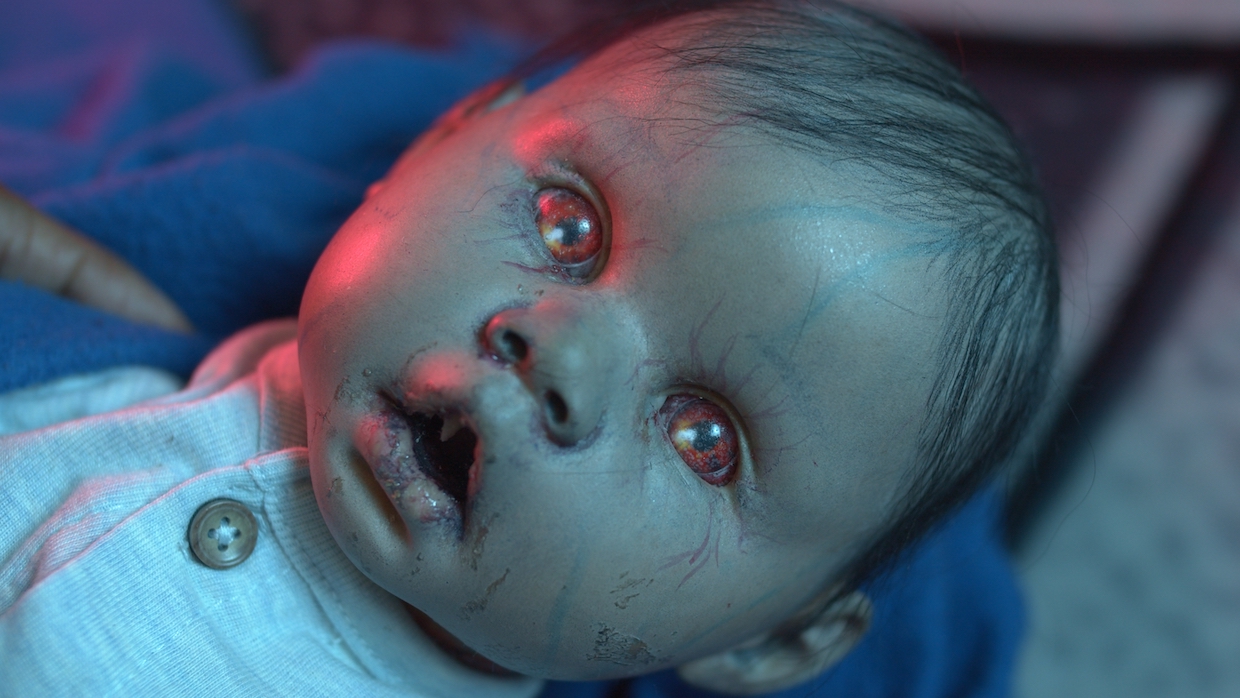 The baby vampire of Live Evil
The baby vampire of Live Evil I loved shooting on film. Nothing was more exciting than the day of the telecine transfer—I finally got to see how the movie would look—but the day the bill was due, my attitude would always change. I hoped that one day the inflated price of the film transfer would come down to a realistic number that made sense. That day is now!
My film making career started in the mid-1990s in Florida, around the same time digital was born. I can remember all my friends shooting on Mini-DV and nudging each other saying, “Check out how great the Canon XL-1 looks on TV. It almost looks like film.” That camera was cool for its day, but it wasn’t the look I wanted for my films.
I felt some of my peers were lazy and lacked the discipline, knowledge and finances to shoot on film. With no film school or YouTube tutorials, I purchased a 16mm K-3 online for about $300. I was sure that this would be my way to stand out. Spike Lee had a K-3 in his hands on the set of Get on the Bus. Like him or not, his movies always looked like real movies and they had a cool look. That’s all I knew or cared about—the K-3 was good enough for me.
From the early 2000s to 2011 I shot a few hundred thousand feet of film on all different types of cameras, from Panavision to Éclair, Arri 2c and even Bolex. Most of the film was Super 16mm. I also tried out Super 8mm, and my last foray in the world of film was with the under-utilized 3-perf 35mm.
This is where I come clean. There were times I would call Kodak or Fuji. They would give me a few cans of free “test footage.” I would take the film and sell it for about 80% of the factory price, then travel down to Dr. Raw Stock in Hollywood and buy tons of short ends and re-cans with that money. I have a feeling I wasn’t the only one doing this type of raw stock acquisition. In all fairness, I did purchase a lot too.
Purchasing film or “acquiring it” was not a problem. Developing? Not really a dealbreaker either. The Mt. Everest was always the telecine transfer. The friend rate (I use that term loosely) was $250 an hour for standard definition telecine. When HD telecine came along, however, forget about it—I was priced out of the market completely. Digital Intermediate was unattainable unless you were a studio level film or a guy with a rich daddy.
In 2009, I completed and sold my second feature film Live Evil: 45,088 feet, over 20 hours of footage. The opening scene was shot in March of 2006, with most of the remainder spread out over 2007. The film premiered at the Valley Film Festival in North Hollywood in September 2008. HD telecine existed, but with the economy rapidly tanking, the project limped through postproduction and completed the film in SD with delivery on a Digi-Beta.
Now, don’t get me wrong: it was a fantastic experience. Warner Bros. released the film in the US on VOD in November 2009. The movie sold a bunch of overseas territories, some of which the other producers and myself are still waiting to get paid on. (Haha! We’re never getting paid.)
It was a mini-miracle to get the sales and see the money that we did when we did. The Great Recession hit hard in 2009, bringing one of the country’s highest unemployment rates in recent memory. Who was going to buy an indie film on this new VOD platform if they were laid off? Fuji film was going out of business, and Kodak was about to file bankruptcy. No more free film. Those who were still actively shooting were going with Arri Alexas, or more realistically whatever affordable DLSRs were out there. I didn’t feel the digital revolution was 100% there yet and stuck to my guns and my love of film.
By 2011, the industry, and quite frankly, the country, seemed to slowly recover. I shot my next film, The Meltdown, which was more of a concept piece, on Panavision 3Perf Kodak Vision 3 35mm and transferred it, for the first time ever, on an HD Telecine. It looked solid for having only a basic color pass.
Meanwhile, film incentives were popping up everywhere—New Mexico, Georgia, Michigan and Louisiana. I chose New Orleans to reinsert myself back in front of the camera. On my way back east, I was able to relocate my entire filmed archive to my home state of Florida. I thought, “Maybe one day if I hit the lottery, I can rescan Live Evil and my shorts into HD and get a grade that had some time behind it.” Around 2012-ish, I was told it would cost north of $20k to get a 1080 scan of my entire negative with the equipment available at the time. A few vendors gave me this price estimate; without even asking specifics of the process, I politely declined.
A few years passed. Even though I was still skeptical about digital cameras, a filmmaker buddy turned me onto Blackmagic Design’s line of cameras and software like DaVinci Resolve. That’s right: Blackmagic Design purchased DaVinci Resolve and gives it away for free on their site. Wasn’t that the same program I was paying telecine colorists thousands to work on just a few years ago? Now I could grade on my own laptop. Unreal.
Little did I know Blackmagic Design was about to acquire some hardware that could and should change the game for every guy out there like me, that has a closet full of film, or the new guy who desperately wants to shoot film but fears the expense. (Let me 100% transparent. I do not work for Blackmagic Design. I was using their products long before their company ever knew I even existed.) Blackmagic Design purchased the game-changing film scanning machine Cintel. The company was founded over 90 years ago and the Spirit DataCine Telecine was the expensive culprit at the end of the equation for many filmmakers transferring films.
Blackmagic Design announced the acquisition of Cintel on July 24th, 2012. Blackmagic Design’s Cintel Scanner is an affordable machine that scans 35mm and 16mm in 4k. The greatest aspect of the Cintel Scanner is that its files seamlessly flow right into DaVinci Resolve—from scanning straight to your color grade. The software that comes with the Cintel Scanner even recognizes the audio track on the film print and imports it straight into DaVinci Resolve. The machine itself is extremely easy to use and set up.
I recently read an article about a filmmaker who was dying to get his 35mm feature onto Amazon Prime. He and I had similar stories—shot on film, international agent didn’t pay him, spent a ton to telecine transfer in SD to an interlaced Digi-Beta master. Unlike me, this guy had a print! So, what he do? He did what, up until now, was the only affordable option for many of us: he made a SD to HD up-resed version of his Digi-Beta master. If any of you have ever tried to save a low-quality image at a higher resolution—well, I don’t need to explain anymore.
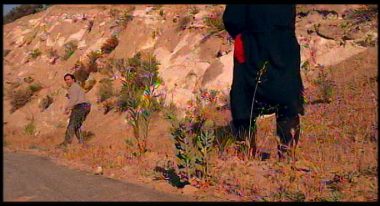
 Samurai Priest (Tim Thomerson) chases a background performer/vampire, shot on 35mm. SD transfer left, HD right.
Samurai Priest (Tim Thomerson) chases a background performer/vampire, shot on 35mm. SD transfer left, HD right.
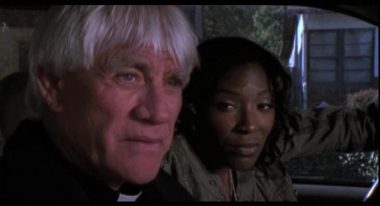

Super 16mm Samurai Priest (Tim Thomerson) and Roxy (Kimberly Sanders). Bad purple tint from SD Telecine is gone. Skin tones are more realistic. Grain structure is solid.
There are some postproduction vendors who own Cintel Scanners. Some even offer rates of $250 per hour at a 1 to 1 ratio. I don’t want to price anyone out, but maybe those are “friend rates.” The point being, this filmmaker (in theory) could have had his entire 90-minute film scanned at 4k for $325.00 plus the price of a hard drive. Back in the day, we would be lucky to get a telecine colorist do one hour of dallies at a two to one ratio for that price! The Cintel Scanner can also be purchased at a fraction of the cost compared to the cost of a SD telecine machine during its heyday. Since a lot of our budgets were low, we would have been lucky to get a decent telecine colorist to give us a solid color pass. I know my films never had a true color grade and it’s still hard for me to believe that DaVinci Resolve color grading is now one of the most accessible parts of the process.
There is an ending to this story. I had my film Live Evil as an SD master—not the best cut in the world and really no color grading. I spent three years of my life creating this project and own the copyright 100%, but Live Evil as it was could never find a home in today’s marketplace. It would be like trying to sell a house with no roof.
Recently, I put the roof back on Live Evil. The entire negative was rescanned. Most of the film is Super 16mm. 16mm comes in at around 2k when up-resed 11% via the Cintel Scanner. The 35mm we shot scans at just under 4k on the Cintel Scanner, but when taken down to 2k it matches perfectly.
16mm tends to be under exposed. With lower-end cameras and lenses, that was absolutely the case during our production with lower-end cameras and lenses. With this type of bad 16mm grain and lack of exposure, the Neat Video Plugin couldn’t make a dent. What I, along with the film’s new editor Mike Hoffman, learned is that the bad grain can be removed in DaVinci Resolve Studio at the highest resolution possible. The Studio version of DaVinci Resolve is worth every penny when dealing with our project like ours. The obvious goal is to preserve skin tones’ realistic texture—we couldn’t have the actors looking waxy and overdone. CineGrain has finer 35mm grain that can then be added onto the scanned footage. This simple process helped the film more than I can explain in writing.
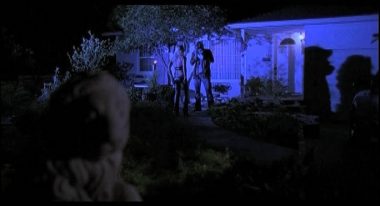
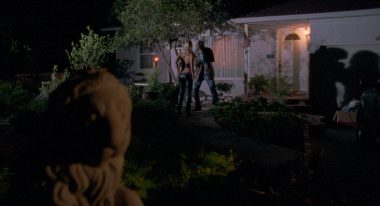
SD on the left, HD on right. Super 16mm, was originally shot with Blue Party gels. This before and after shows the dynamic range of the Cintel. We wanted to get rid of the blue look and were actually able to grade it to a realistic and more detailed look.
Since we are going back and fixing things anyway, I figured I might as well pull a George Lucas and also fix some of the scenes that had poor special effects, namely the infamous Baby Vampire Scene. For this, the Blackmagic Pocket Cinema Camera 4K with a Sigma 18-35mm Art lens was a near perfect match after adding in our 35mm grain, then down-resing to 2k. The Sigma 18-35mm is popular and flexible with filmmakers because it can be used on different cameras and looks fantastic. However, Sigma does have brand Micro Four Thirds prime lenses that come in at 16mm, 30mm and 56mm.
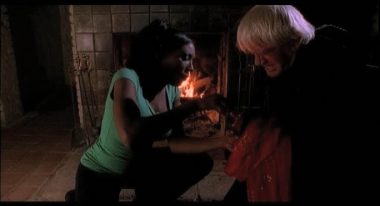
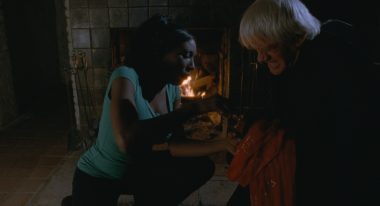
Super 16mm of Samurai Priest (Tim Thomerson) and Roxy (Kimberly Sanders). Look at the interlacing in Roxy’s green shirt. That is cleaned up in the scan and again it comes out clean, even in low light.
During the process of reshooting the Baby Vampire Scene I was sent the wrong lens adapter for the Sigma 18-35mm Art. Thankfully ShareGrid exists. If you are not familiar with ShareGrid, the only way I can explain it is it’s like the Airbnb of camera and lens rentals. I was able to rent and pick up the correct adapter through ShareGrid with insurance coverage that evening! ShareGrid first began on the west coast but is now expanding throughout the US. Shifting gears back to the postproduction process, keeping the film’s LUTs consistent during the grading process over all the film formats, and the new digital footage as inserts, has been an incredible success.
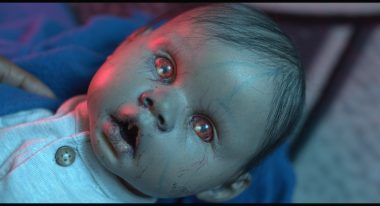
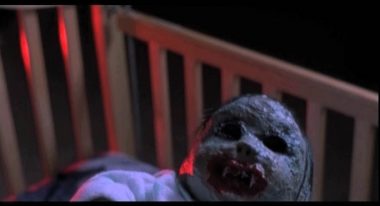
The 4K still (left) is the new baby vampire that was shot on the Black Magic Pocket Cinema Camera 4k. The SD baby vampire is on the right.
There are expensive scanners out there, expensive cameras and lenses. Yes, there are other ways to skin a cat or scan your film, but this process was clearly the most economical, satisfactory, and realistic for a film that needed to be scanned, recut from scratch and color graded.
Maybe you have the negative of that film school 35mm short that is just sitting in your closet or a feature like mine. It can be done. I’ve given you the basic blueprint. The Blackmagic Pocket Cinema Camera 4K along with Sigma’s line of lenses do the trick to match and give your film new life. Get your film back out there. When you get it done, don’t forget to add my name in the “special thanks” section.
***
Mark Terry is a 10+ year SAG-AFTRA actor and stunt performer. His features and shorts have screened and sold all over the world.
His first fully digital film Protocol: New Orleans is currently on Amazon Prime.The film was shot completely on the original Black Magic Pocket Cinema Camera.
The new Live Evil, which is being rebranded as Samurai Priest Vampire Hunter, will release in 2020.
@MarkTerryOnline on Twitter
www.markterryonline.com www.liveevilthemovie.com www.samuraipriest.com
